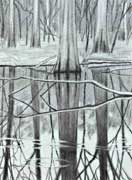 |

by by Gary Pendleton |
 Life and Death Drama in Vernal Pools
Life and Death Drama in Vernal Pools
Short works of non-fiction on seemingly prosaic subjects are a new trend in the world of publishing. Such books have been written about a species of fish, a table condiment and a humble piece of hardware. Cod, salt and the screw are the subjects I am referring to, and they are just a few examples.
Readers are amazed at the fascinating and complex histories the little subjects have. The stories reveal much about the complexity and interconnectedness of the world at large. A Biography of the Fish that Changed the World is the audacious subtitle of Cod by Mark Kurlansky. After reading it I wouldn’t take issue.
Thinking about vernal pools reminds me of one of these books. What may be a puddle of wet leaves to the uninitiated — is really a very complex biological system. There is life — and death drama with energy flowing through it all.
In early spring, having had normal amounts of rain and snow in the fall and winter, the pools are almost full. By definition, they will not stay that way, and by early summer the standing water will be gone.
These pools that, though in forests, still reflect
The total sky almost without defect.
I’m glad that Robert Frost mentioned the sky in “Spring Pool.” That is where it starts, because that is where the sun is. Though we are talking about spring, it is last summer’s leaves that will feed the system now. I told you it was complex.
A portion of the flux of solar energy that fell last summer was converted to carbon in the leaves of trees that shaded the wet ground. The fallen leaves become food for a microscopic host of herbivores. The leaves and other matter are called detritus.
As the water warms, thermally cued hatchers such as mosquito larvae appear, for their eggs were there all along. As the tiny creatures feed on leaves and algae, the detritus is converted from vegetable matter to the cells of living animals.
Rain triggers additional streams of energy into the watery system. Toads, wood frogs, spring peepers and salamanders begin their migration to the pool with evening rains. The gelatinous egg masses they deposit provide additional fuel. Only a fraction of the eggs laid will make it to larvae and adult. The rest feed predators.
Spotted salamanders are among the best known species associated with vernal pools. They exhibit a high degree of fidelity to their breeding pools, returning year after year. Individual spotted salamanders usually enter and leave the pools along the same compass headings and use the same route from season to season.
Just a puddle of wet leaves? Or is there enough going on in vernal pools for a curious biologist to devote a life of study?



 Life and Death Drama in Vernal Pools
Life and Death Drama in Vernal Pools